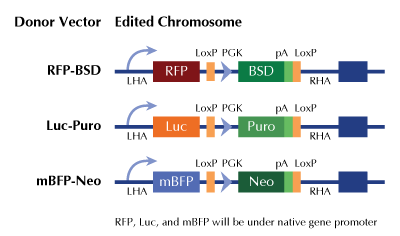MID1 Human Gene Knockout Kit (CRISPR)
CAT#: KN208776RB
MID1 - human gene knockout kit via CRISPR, HDR mediated
Functional Cassette: GFP-puro Luciferase-Puro mBFP-Neo
HDR-mediated knockout kit validation
USD 1,657.00
4 Weeks*
Specifications
| Product Data | |
| Format | 2 gRNA vectors, 1 RFP-BSD donor, 1 scramble control |
| Donor DNA | RFP-BSD |
| Symbol | MID1 |
| Locus ID | 4281 |
| Components |
KN208776G1, MID1 gRNA vector 1 in pCas-Guide CRISPR vector KN208776G2, MID1 gRNA vector 2 in pCas-Guide CRISPR vector KN208776RBD, donor DNA containing left and right homologous arms and RFP-BSD functional cassette. GE100003, scramble sequence in pCas-Guide vector |
| Disclaimer | These products are manufactured and supplied by OriGene under license from ERS. The kit is designed based on the best knowledge of CRISPR technology. The system has been functionally validated for knocking-in the cassette downstream the native promoter. The efficiency of the knock-out varies due to the nature of the biology and the complexity of the experimental process. |
| Reference Data | |
| RefSeq | NM_000381, NM_001098624, NM_001193277, NM_001193278, NM_001193279, NM_001193280, NM_001193281, NM_033289, NM_033290, NM_033291, NM_001347733 |
| UniProt ID | O15344 |
| Synonyms | BBBG1; FXY; GBBB1; MIDIN; OGS1; OS; OSX; RNF59; TRIM18; XPRF; ZNFXY |
| Summary | The protein encoded by this gene is a member of the tripartite motif (TRIM) family, also known as the 'RING-B box-coiled coil' (RBCC) subgroup of RING finger proteins. The TRIM motif includes three zinc-binding domains, a RING, a B-box type 1 and a B-box type 2, and a coiled-coil region. This protein forms homodimers which associate with microtubules in the cytoplasm. The protein is likely involved in the formation of multiprotein structures acting as anchor points to microtubules. Mutations in this gene have been associated with the X-linked form of Opitz syndrome, which is characterized by midline abnormalities such as cleft lip, laryngeal cleft, heart defects, hypospadias, and agenesis of the corpus callosum. This gene was also the first example of a gene subject to X inactivation in human while escaping it in mouse. Alternative promoter use, alternative splicing and alternative polyadenylation result in multiple transcript variants that have different tissue specificities. [provided by RefSeq, Dec 2016] |
Documents
| Product Manuals |
| FAQs |
| SDS |
Resources
Other Versions
| SKU | Description | Size | Price |
|---|---|---|---|
| KN208776 | MID1 - human gene knockout kit via CRISPR, HDR mediated |
USD 1,657.00 |
|
| KN208776BN | MID1 - human gene knockout kit via CRISPR, HDR mediated |
USD 1,657.00 |
|
| KN208776LP | MID1 - human gene knockout kit via CRISPR, HDR mediated |
USD 1,657.00 |
|
| KN408776 | MID1 - KN2.0, Human gene knockout kit via CRISPR, non-homology mediated. |
USD 1,657.00 |
|
| GA102908 | MID1 CRISPRa kit - CRISPR gene activation of human midline 1 |
USD 1,657.00 |
{0} Product Review(s)
Be the first one to submit a review






























































































































































































































































 Germany
Germany
 Japan
Japan
 United Kingdom
United Kingdom
 China
China
